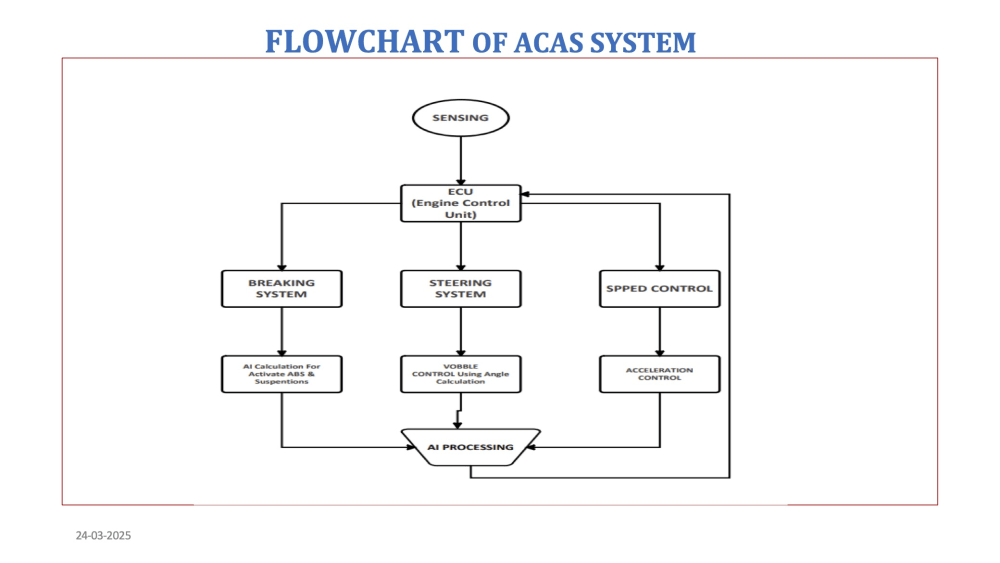In India's congested urban environments, motorcycles frequently encounter unpredictable obstacles such as pedestrians, stray animals, rickshaws, and sudden vehicle maneuvers—especially in narrow lanes and crowded markets. Traditional braking systems rely solely on rider reflexes, which are often not fast enough to avoid collisions. Sudden braking can lead to skidding, imbalance, and even fatal crashes, particularly on wet or uneven roads.
The Anti Crash Assist System (ACAS) is a smart, AI-powered safety solution designed to address these challenges. It integrates real-time obstacle detection, smart braking algorithms, and rider stability control to automatically assess threats and adjust speed or apply brakes accordingly. By doing so, it ensures a smoother, safer ride even in chaotic traffic conditions.
This system is tailored for Indian roads, aiming to:
- Detect sudden obstacles intelligently.
- Calculate and apply safe braking without destabilizing the rider.
- Prevent skidding and falls, especially on bad roads or sharp turns.
ACAS brings a significant innovation to two-wheeler safety by combining machine learning, sensor fusion, and smart control systems—ultimately reducing the risk of accidents and enhancing rider confidence.
The ACAS system works in four major steps:
- Obstacle Detection: Using LiDAR, radar, ultrasonic sensors, and cameras, the system detects sudden obstacles in the path.
- AI-Based Decision Making: The processing unit calculates the best action (slow down, brake gradually, or maneuver) based on obstacle position and speed.
- SmartBraking&StabilityControl:Thesystemappliesabalancedbraking force (front & rear) using ABS and electronic braking control (EBC) to avoid skidding or tipping.
- Rider Alerts & Assistance: Visual/audio alerts or haptic feedback inform the rider about critical situations.
ACAS combines hardware and software to ensure safe braking in critical situations. It uses LiDAR and ultrasonic sensors for real-time obstacle detection, while a camera helps recognize objects. Accelerometers and gyroscopes maintain bike stability by detecting tilt and balance, and a speed sensor assists in braking calculations. A microcontroller (ESP32, Raspberry Pi, Arduino) .The braking system includes Electronic Braking System (EBS), Anti-lock Braking System (ABS), and servo motors to prevent skidding and loss of control. A battery powers the system, and data is exchanged through a CAN Bus network, with Wi-Fi/Bluetooth enabling remote monitoring and updates.
The ACAS software processes sensor data to make smart decisions. A Sensor Fusion Algorithm combines inputs from LiDAR, ultrasonic sensors, and cameras to map the road. AI models like YOLO or MobileNet detect obstacles and assess risks. A Risk Assessment Algorithm calculates accident chances based on speed, distance, and road conditions, while a Braking Algorithm controls braking for stability. A PID Controller ensures smooth braking, and a fail-safe system activates emergency braking if needed. A mobile app provides real-time updates, and cloud connectivity enables data storage, updates, and system improvements.
The AI-based braking system follows mathematical calculations to prevent falls and ensure safety:
- Braking Force Calculation: F brake=m⋅a , ensuring force does not exceed stability limits.
- Skid Prevention: Ensuring braking force < friction limit to prevent wheel slip.
- Tipping Condition Check: Using torque balance equations to avoid forward flipping.
- Jerk Analysis: Controlling rate of deceleration (J = Δa / Δt) to prevent sudden rider displacement.
Like this entry?
-
About the Entrant
- Name:Akashraja A
- Type of entry:teamTeam members:
- SYED SALIH S A
- MOHAMMED AFIL S
- KATHAN K
- Software used for this entry:Arduino IDE, Proteus,SolidWorks or Fusion 360 (if used for hardware design illustrations)
- Patent status:none





